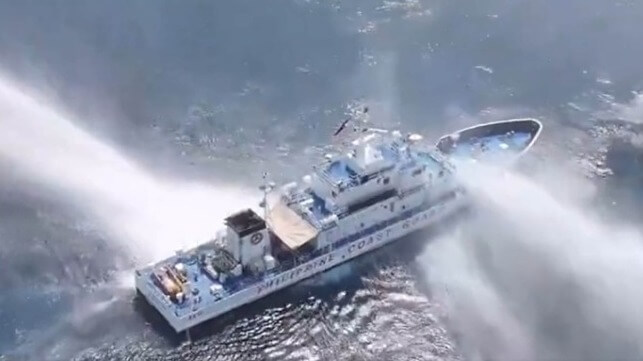China Coast Guard Damages Two Philippine Vessels With Water Cannon

On Tuesday, Chinese forces water-cannoned two Philippine patrol vessels near Scarborough Shoal, a longtime flash point in the South China Sea. It is the latest in a string of near-conflict encounters between China's "gray zone" government ships and the Philippine military, driven by China's ownership claim to a large section of the Philippines' Exclusive Economic Zone (EEZ).
According to the Philippine Coast Guard, the cutter BRP Bagacay and the fishery patrol vessel BRP Bankaw were under way near Scarborough Shoal when they encountered a small flotilla of China Coast Guard and Chinese maritime militia ships. China maintains a constant presence at Scarborough Shoal, which it has controlled since 2012.
At about 0950 hours, the China Coast Guard cutter CCG-3305 used its water cannon to target the starboard quarter of BRP Bankaw, spokesman Commodore Jay Tarriela said. Though not confirmed by Philippine officials, a reporter's video footage appears to show that CCG-3305 also shouldered the Bankaw and used its water cannon at close range to break the radome off Bankaw's satcom terminal.
WATCH: Video shows exact moment a China Coast Guard collided with Philippine vessel BRP Datu Bangkaw near Scarborough Shoal, Tuesday, April 30. @News5PH pic.twitter.com/ughvD6yC2Z
— Gio Robles (@_GioRobles) April 30, 2024
At about the same time, as BRP Bagacay approached to within 1,000 yards of Scarborough Shoal, two other Chinese cutters used their water cannons to target the Philippine Coast Guard vessel. The PCG cutter reported damage to its topsides, including railings and a cloth canopy, but no personnel were injured. An embarked reporter from UK paper the Telegraph added that the cutter sustained interior flooding and damage to a radar system.
BRP Bagacay sustained damage on its left side, the railings crumpling and damaging the LED character display of the ship. The Canopy at the back of the ship likewise sustained heavy damage. pic.twitter.com/GqfxS5K7BO
— Raffy Tima (@raffytima) April 30, 2024
One of the Chinese cutters involved, CCG-5303, is familiar from previous encounters in the South China Sea. It was part of the Chinese presence in Indonesian waters in the Natuna Islands in 2021 and at Second Thomas Shoal in 2022. It has been tailing Philippine vessels near Scarborough Shoal for weeks, according to PCG spokesman Commodore Jay Tarriela.
Under its "nine-dash line" policy, China claims sovereignty over the vast majority of the South China Sea, including waters and land features located hundreds of miles from the Chinese mainland. Most of these claimed areas are located within the exclusive economic zones of neighboring countries, and none have formally accepted it. In 2016, an international tribunal ruled in Manila's favor and found that China's sweeping claims were invalid under international law.
